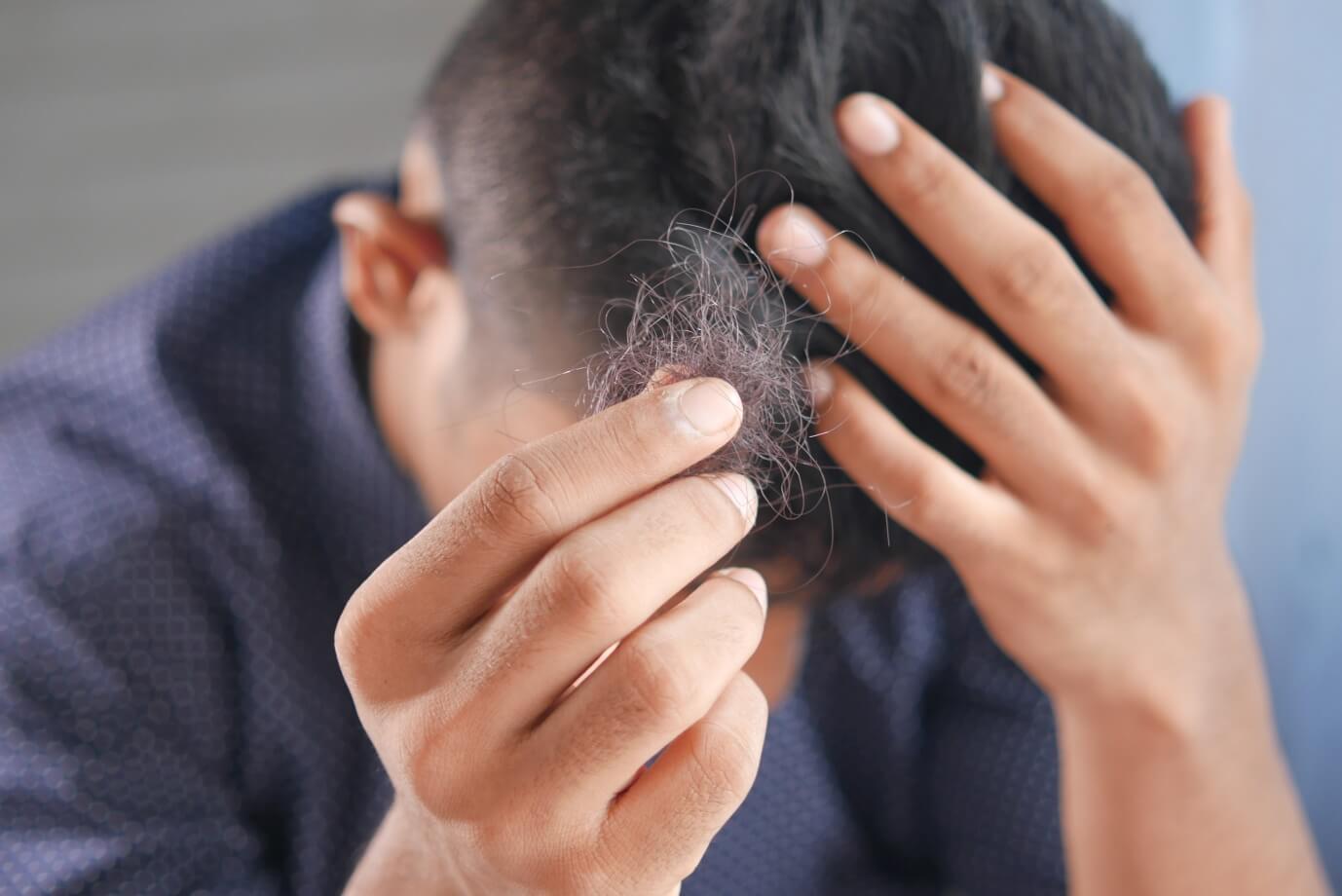How Does Finasteride Work for Hair Loss? All You Need to Know
- Written by Lisa Sawter
- Aug 2, 2022
- |
- 6 min read
 Listen to the full text
Listen to the full text
Finasteride is a type of drug called an “anti-androgen.” This essentially means that it blocks the effects of male hormones in the body (in this case, testosterone). By doing so, finasteride helps stop the progressive thinning of hair and density that is commonly known as male-pattern baldness. If you’ve been researching hair loss treatments and their potential side effects, you probably already know that finasteride can lead to negative sexual side effects in some men. However, even with those risks in mind, there are many compelling reasons to choose this medication—especially if you have a family history of early-onset male pattern hair loss.
What Can Cause Hair Loss?
90% of our scalp hairs are anagen hairs, which are growing, and 10% are telogen hairs, which are resting. Anagen, the hair growth phase on our scalp, lasts about three years, and telogen, the phase of hair dormancy that follows it, lasts between two and six months. After telogen finishes, anagen hairs gradually replace our hairs, bringing the cycle to a close.
When we are stressed, our bodies prematurely shift an abnormal amount of telogen hairs into a resting state, resulting in an abnormal amount of hair resting and shedding. Normally, we lose about 100 to 150 hairs a day.
Buy top-quality wigs for men to recover from hair loss
There are three main causes of hair loss, which are genetics, age, and certain health conditions. Genetics can determine how long your hair stays on your head, while age and certain health conditions can increase the rate of hair loss. Although these three factors can cause normal hair loss, many other reasons can lead to hair loss. These include:
- Excessive pulling on the hair (ex. traction alopecia caused by hair extensions or wigs)
- Excessive styling of the hair (ex. putting too much heat on the hair)
- Improper hair care (ex. not using the right shampoo or conditioner)
- Certain medications
- Mental or emotional stress
- Nutritional deficiency
- Vitamin or mineral imbalance
- Certain diseases or disorders
What Is Finasteride?
If you’ve been experiencing hair loss, finasteride can help stop the effects of male-pattern baldness from progressing. Finasteride is a synthetic drug that inhibits the enzymes that convert testosterone into dihydrotestosterone (DHT). By inhibiting DHT production, it helps protect the hair follicles from miniaturization and promotes regrowth of healthy hair growth. The 1mg daily dosage of finasteride is used to treat hair loss. It is available in tablet form and taken daily.
How Does Finasteride Work for Hair Loss?
Finasteride is a synthetic 5-alpha reductase inhibitor. 5-alpha reductase is an enzyme that converts testosterone into dihydrotestosterone (DHT). DHT has been linked to hair loss in men. By inhibiting 5-alpha reductase and lowering DHT levels in the scalp, finasteride can help stop hair loss and promote hair regrowth.
DHT can impact most of the hair you lose as a consequence of male pattern baldness, with the exception of the hair follicles on the sides and back of your head (the “horseshoe” pattern). The ones around the front, top, and crown of your head are usually more susceptible to DHT than those on the sides and back.
Because finasteride reduces total DHT levels, logically you should be prevented from losing hair around your hairline. However, the information about finasteride offers a detailed description of its ability to prevent baldness on the top and back of the head.
Which Types of Hair Loss Does Finasteride Treat?
The most common type of hair loss in men, male pattern baldness, is currently treated with finasteride, which is authorized by the FDA. However, other kinds of hair loss may also impact you including:
Telogen effluvium
Severe stress, infections, surgeries, fevers, nutritional deficiencies, and certain medications cause temporary hair loss.
Best hair replacement systems to overcome hair loss problems
Alopecia areata
Although the precise cause of this type of hair loss is unknown, it is thought to be caused by stress, infections, and certain medications. Small, round patches of hair loss are typical symptoms.
Tinea capitis
Scalp ringworm is a kind of fungal infection that results in patchy hair loss.
DHT isn’t responsible for these kinds of hair loss, so finasteride is ineffective at decreasing them, stopping them, or reversing their effects.
How Effective Is Finasteride?
According to clinical studies, finasteride is effective in preventing hair loss in men. It typically takes 3-6 months for finasteride to have an effect, but in some cases, it causes hair regrowth. Your hair loss will return if you discontinue taking Finasteride.
Finasteride is most effective in treating male pattern baldness in which hair loss occurs on the top of the head. There is no proof that it reverses receding hairlines. You should not take more than one tablet of Finasteride each day. It will not work faster or better if you do.
There has been a lot of research on finasteride, and the outcome has been very favorable for men who want to keep their hair. After using finasteride continuously for one year, you can expect to see significant improvements in your hair growth.
Buy hairpieces for thinning hair for fast recovery
Does Finasteride Work in All Men?
Finasteride can be helpful for many men. However, it’s important to note that it isn’t the perfect fix for everyone. This is because the effects of finasteride can vary from person to person. It also depends on the severity of your hair loss and when it started. This is because the medication takes time to work, which can be anywhere from three to six months. If you have had hair loss for a long time, finasteride may not be as effective as it would be if you were to take it when your hair loss first started.
According to research, taking finasteride has been shown to halt hair loss for 83% of men, and 66% of men will regrow their hair over two years. In addition, over five years, the drug was shown to be capable of halting hair loss in as many as 90% of men.
How Do You Take Finasteride?
You can take finasteride once per day with or without food. It is important to take it at the same time every day so that you can keep track of how your body responds to the medication. You should continue taking finasteride every day even if you’re experiencing positive effects. In order to maintain a constant level of Finasteride in your body, you must take it daily, as its half-life is only about five to six hours (meaning that half of the dose is eliminated every six hours).
Everyone, regardless of height, weight, or age, receives the same dosage of Finasteride to treat hair loss: 1mg. Only 1mg of Finasteride daily is necessary to effectively treat hair loss. It is important to note that taking a higher dose will not increase the treatment's efficacy.
It's worth noting that there are some exceptions: If you are taking Finasteride for an enlarged prostate gland, make sure to talk to your physician. Only men aged 18 and above should take finasteride. Children and adolescents are not permitted to do so.
It is also imperative to avoid handling Finasteride tablets if you’re a woman who is pregnant or breastfeeding, as they may absorb into the body and cause serious side effects. Women must also avoid taking Finasteride because it interferes with female hormones and may cause serious side effects.

How Long Should You Take Finasteride?
You should take finasteride for as long as your doctor prescribes it. Some men choose to stay on finasteride for the rest of their lives; others discontinue after a certain period. The decision to stay on it for a long time depends on your age, the severity of your hair loss, and your risk of developing other health conditions.
However, it’s important to note that finasteride can be a lifelong treatment. It’s not like other hair loss solutions, like hair transplants or lasers, which can be “cured” with a one-time treatment. Instead, you need to take finasteride consistently or the effects will wear off eventually and your hair loss will be back full force.
It may take up to six months for you to notice a difference in your hair loss after starting to take Finasteride daily. You should continue taking it for at least a year to determine whether it is effective for you.
What Happens If You Miss a Dose?
Despite being a very effective hair loss treatment, finasteride only functions while you are taking it. Your hair loss will continue if you stop taking Finasteride because your body will once again start converting testosterone to DHT. Missing one day of Finasteride won't have an impact, so you don’t need to worry.
If you miss a dose of Finasteride, take the dose as usual - at the regular time and with the regular quantity. Do not take an extra tablet to compensate for the missed dose.
While missing a single dose of Finasteride will have no noticeable effect on your hair regrowth, it is crucial to stick to your regular treatment routine. If you start to regularly skip doses, your hair loss will resume, and your hair growth will halt.
What Are the Side Effects of Finasteride?
Finasteride can cause unwanted side effects in some men. The most common side effects include:
Sexual side effects include decreased libido, decreased interest in sex, erectile dysfunction (ED), and/or reduced semen volume; headache; rash; joint pain; muscle pain; depression; anxiety; trouble sleeping; itching; and nausea.
Most of these side effects are mild. However, the potential sexual side effects can be so severe that some men are forced to discontinue the treatment. If you experience sexual side effects, it’s important to consult with your doctor. They can help you identify the cause and recommend treatment.
Before taking finasteride, consult a doctor and disclose all relevant patient data, such as current medications, supplements, and health hazards.
Final Words: Is Finasteride Right for You?
As you can see, finasteride has a lot of benefits for those who experience hair loss if used correctly and safely. However, it isn’t for everyone. If you experience hair loss, it’s important to consult with your doctor to find out if it’s right for you. While finasteride can help prevent hair loss, it may not be able to stop hair loss that has already progressed significantly.
Additionally, it’s important to keep in mind that finasteride can take six months to kick in, which means it’s important to be patient. No matter what treatment you choose, it’s important to be patient and consistent with your treatment.
Your doctor recommends taking your medication exactly as prescribed to avoid any side effects and to ensure that you are treating your condition as well as possible.

Also, read our recent blog posts:
Learn everything about double crown hair
Discover the best hairpieces for women
Learn everything about different types of perms for men


